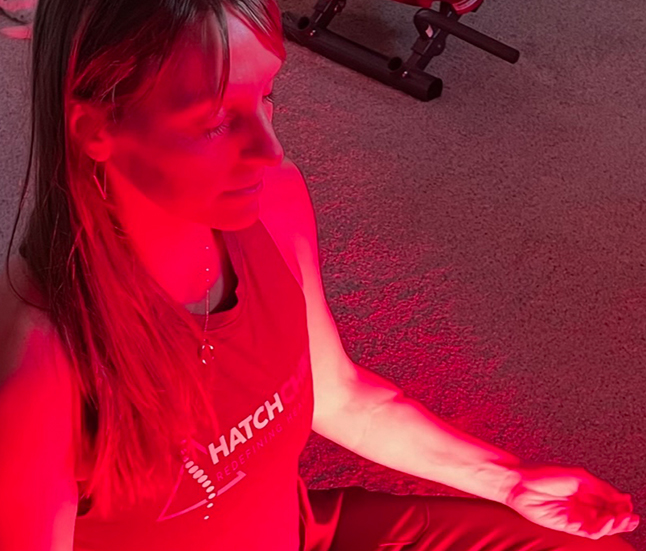fringe red light therapy basics faq
Welcome to the broad (and bright) world of Red Light Therapy, we’re happy to see ya. You probably have some questions, and we’ve got answers – let’s talk it out.
Red and near infrared light are part of the spectrum of light emitted by the sun (and by fire light too). When red and near infrared light are used therapeutically, it is commonly referred to as “Red Light Therapy.” Most of the research surrounding the bioactive effects of red and near infrared light fall in specific ranges of 630-680 nm and 800-880 nm.
RLT is also known as Photobiomodulation (PBM), a term specifically referring to the science of the non-thermal interaction of light on the cells in our body.
Red light and near infrared light have overlapping benefits for our body. For this reason, it is commonly recommended to use them together.
The health of every organ and cell in the body depends on energy being produced by the mitochondria in those cells. Skin, muscle, fat, bone, gland, or brain – when the mitochondria produce more energy, the cells in those tissues work better.
- Increased Cellular ATP Production
Red and near infrared light therapy stimulates your body’s natural healing process at the cellular level through increased ATP production by the mitochondria. With an increase in mitochondrial ATP a series of metabolic events occur that may improve blood oxygenation, improve blood flow, increase collagen production, reduce overall inflammation, and improve cellular regeneration and protection.
- Building Cellular Antioxidant and Anti-Inflammatory Defenses
Light entering our skin creates a low-dose healthy metabolic stress (hormesis) that builds our cell’s anti-inflammatory and antioxidant defense systems. This results in a reduced amount of cellular free radicals being produced and less oxidative stress for our cell, protecting our tissues from further inflammation.
- Circadian Rhythm
Red light therapy can help regulate our circadian rhythm (sleep/wake) cycle. By viewing the red light wavelengths in the early morning and evenings (for example, as lighting in a room), you can help to support healthy sleep, hormone, mood and energy levels.
Red Light wavelengths (630-680nm being the most common range) are absorbed in highest proportions by our skin, making it very effective for improving skin health and collagen production. The visible nature of Red Light also has health benefits when observed by our eyes in an ambient light setting, including improved sleep and mood.
Near Infrared light wavelengths (common range of 800-880nm) are not visible to the human eye, but that does not mean they are not working. On the contrary, near infrared light can penetrate deeper into our tissues making it ideal for reducing pain, inflammation, and speeding recovery. Near infrared light cannot be seen, but can be felt as heat.
Red light and Near infrared light scatters once it enters our skin and they have overlapping benefits for our body. It’s for this reason they are commonly recommended to be used together, as they are in Fringe Red Light Therapy products.
Irradiance is the amount of light energy your skin receives over a period, often reported in mW/cm² (milliwatts per centimeter squared, or amount of power over a surface area). Clinical studies often report red light irradiance along with the time of use as “dosage.” Higher irradiance or power does not mean better results, if the dose is too great – the benefits are negated!
Many companies claim to have and irradiance of 100mW/cm² (or more) at 0 inches.
Man, that would be HOT! The sun is about 24 mW/cm² on our skin, and we think the sun knows a thing or two about healing! Think of your Fringe Red Light Therapy as a way to safely supplement the healing wavelengths from the sun that offer us the most benefits.
Laser red light therapy produces parallel, uniform rays of light at one wavelength. They can treat a small area, the rays travel deeper than LED lights and they can create more heat.
LED red light therapy (like with Fringe red light therapy products) produces non-parallel, non-uniform rays of light in a small range of wavelengths. They can treat a larger area, the rays don’t travel as deep and they create less heat.
Recent scientific studies have confirmed that you can get the same benefits from LED Red and Near Infrared light therapy as you can from lasers, at a fraction of the cost. Thankfully, this increases its accessibility to be used in clinics and at home, with the same healing benefits as red light laser therapy!
Here are just a few
Photobiomodulation (PBM)
Photobiomodulation therapy (PBMT)
Low-level laser therapy (LLLT)
Cold lasers
Low intensity light therapy (LILT)
Phototherapy
Photobiostimulation
Biostimulation (BIOS)
Photomedicine
Blue light wavelengths in the 400s nm range are antimicrobial in nature, making them beneficial for certain skin and pelvic health uses. When blue light is used therapeutically, it is commonly referred to as “Blue Light Therapy.”
Our skin contains molecules called porphyrins that absorb blue light. Porphyrins are found in the glands that produce oil, which can get colonized with acne causing bacteria. When the porphyrins absorb blue light, the acne-causing bacteria are destroyed. This is called a bactericidal effect, and it explains why blue light is particularly effective in treating inflammatory acne, which is caused by bacteria.
Fringe makes 3 products with Blue Light modes: the Face Mask, The Neck & Chest Mask, and the Pelvic Wand.

The statements on this website have not been evaluated by the FDA (U.S. Food & Drug Administration). Our products are not intended to diagnose, treat, cure, or prevent any disease.
FringeLights are considered low-risk, general wellness products that do not require FDA clearance, in accordance with the “General Wellness: Policy on Low Risk Devices” draft released July 29, 2016.


